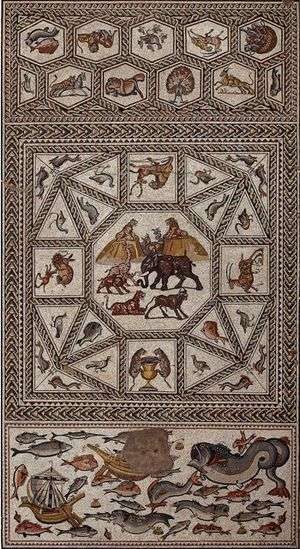Lod Mosaic Archaeological Center

The Shelby White and Leon Levy Lod Mosaic Archaeological Center is an archaeological museum in Lod, Israel that displays one of the largest and best-preserved mosaic floors ever uncovered in Israel.
History
The impetus for establishing the center was the discovery of the mosaic in 1996. It was discovered by construction workers widening Ha-Halutz Street, and archaeologist Miriam Avissar of the Israel Antiquities Authority was immediately called to the site. When the mosaic was uncovered, the authorities opened it to the public during a single weekend over the course of which 30,000 people traveled to Lod to see it. It was then covered while funding was sought to conserve the mosaic.[1] Leon Levy Foundation and Shelby White, Chairman of the Friends of the Israel Antiquities Authority provided the necessary funding to conserve the mosaic and establish the Shelby White and Leon Levy Lod Mosaic Center, which will open to the public in 2012/13. [2]
Description of mosaic
The mosaic covers an area of 180 m2 (1,900 sq ft) and dates to the third century CE. The patterns depict birds, fish, animals and plants, in addition to providing detailed images of Roman-era ships.[3] Nothing is written on the mosaic; inscriptions are common in Roman-era mosaics from public buildings, so it is assumed that the mosaic was most likely part of a private villa. The Center hopes to be able to uncover further mosaics in the future.[1] There are also hopes that tourists coming to see the mosaic will increase the prosperity of Lod.[1]
Because of the high quality of the mosaic, it was exhibited at New York's Metropolitan Museum of Art, at the Legion of Honor in San Francisco, and the Field Museum in Chicago and will be exhibited at the Columbus Museum of Art and the University of Pennsylvania Museum of Archaeology and Anthropology.[2]
Unusually for a mosaic floor of this age, the mosaic is in near-perfect condition. The exception is damage to one of the two ships depicted, done when an Ottoman-era cesspit was dug into the mosaic.[4] Despite the damage, students of maritime history have been able to glean a great deal of information from the images. The ships are of the navis oneraria type, Roman merchant ships typically displacing 80-150 tons, used to carry such commodities as garum and grain form Egypt to Rome.[5]
Archaeologists Elie Haddad and Miriam Avissar suggest that the absence of human figures, rare in Roman-era mosaics, may indicate that the mosaic was commissioned by a Jew who observed the Biblical prohibition of graven images. They further suggest that the expensive mosaic may have been commissioned as a kind of ex-voto, a thank offering in fulfillment of a vow made upon being delivered from grave danger, in this case, shipwreck. Other maritime historians demur,[5] but Haddad and Avissar point to what appear to be a torn ropes, a broken mast and damaged steering oars, together with the central placement of the damaged ship in the mosaic and the fact that it is apparently about to be swallowed by a giant fish as an artists representation of disaster at sea.[4]
External links
- A dedicated website about the Lod Mosaic
- Article about the Lod Mosaic by Metropolitan Museum of Art Curator, Christopher S. Lightfoot
- Artist & Scholar Lillian Sizemore discusses the Lod Mosaic and how ancient Greeks and Romans used the geometric shapes they saw in nature as a foundation for learning by Kathryn Kukula
- Video clip The Lod Mosaic: From Excavation to Exhibition (Jaques Neguer, Director of Art Conservation, Israel Antiquities Authority) on The Metropolitan Museum of Art YouTube channel
- Video clip The Lod Mosaic Floor and Its Menagerie: Roman Influence on Local Mosaic Art (Miriam Avissar, senior archaeologist with Israel Antiquities Authority) on The Metropolitan Museum of Art YouTube channel
References
| Wikimedia Commons has media related to Lod Mosaic. |
- 1 2 3 Kershner, Isabel (2009-07-08). "Polishing a Lost Gem to Dazzle Tourists". The New York Times. Retrieved 2009-07-18.
- 1 2 "Lod mosaic to be re-exposed". Government of Israel website. Ministry of Foreign Affairs (Israel). 2009-07-01. Retrieved 2009-07-18.
- ↑ Negev, Avraham; Gibson, Shimon (2005). Archaeological Encyclopedia of the Holy Land. New York City: Continuum International Publishing Group. p. 348. ISBN 0-8264-8571-5.
- 1 2 Haddad, Elie; Avissar, Miriam (2003). "A suggested reconstruction of one of the merchant ships on the mosaic floor in Lod (Lydda) Israel". International Journal of Nautical Archaeology (Portsmouth: The Nautical Archaeology Trust Ltd) 32 (1): 73–77. doi:10.1111/j.1095-9270.2003.tb01433.x. OCLC 10.1111/j.1095-9270.2003.tb01433.x. Retrieved 2009-07-18.
- 1 2 Friedman, Zazara (2004). "The Ships Depicted in the Lod Mosaic Reconsidered". International Journal of Nautical Archaeology (Portsmouth: The Nautical Archaeology Trust Ltd) 33 (1): 164–168. doi:10.1111/j.1095-9270.2004.0015b.x.
Coordinates: 31°57′21.61″N 34°54′13.68″E / 31.9560028°N 34.9038000°E